2004 CHEVROLET SILVERADO oil pressure
[x] Cancel search: oil pressurePage 437 of 584
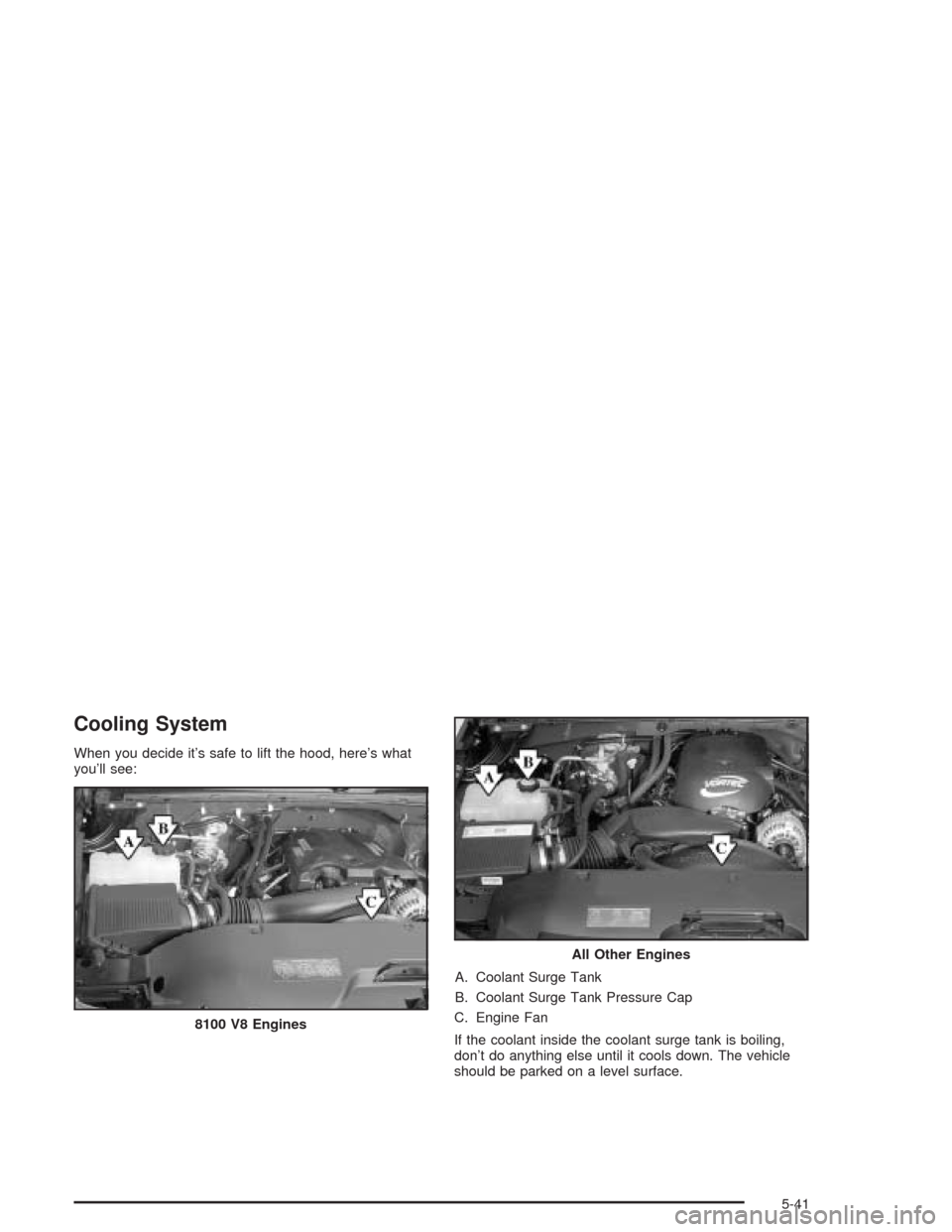
Cooling System
When you decide it’s safe to lift the hood, here’s what
you’ll see:
A. Coolant Surge Tank
B. Coolant Surge Tank Pressure Cap
C. Engine Fan
If the coolant inside the coolant surge tank is boiling,
don’t do anything else until it cools down. The vehicle
should be parked on a level surface. 8100 V8 Engines
All Other Engines
5-41
Page 440 of 584

{CAUTION:
Adding only plain water to your cooling
system can be dangerous. Plain water, or
some other liquid such as alcohol, can boil
before the proper coolant mixture will. Your
vehicle’s coolant warning system is set for the
proper coolant mixture. With plain water or the
wrong mixture, your engine could get too hot
but you would not get the overheat warning.
Your engine could catch �re and you or others
could be burned. Use a 50/50 mixture of clean,
drinkable water and a proper coolant.
Notice:In cold weather, water can freeze and crack
the engine, radiator, heater core and other parts.
Use the recommended coolant and the proper
coolant mixture.
{CAUTION:
You can be burned if you spill coolant on hot
engine parts. Coolant contains ethylene glycol
and it will burn if the engine parts are hot
enough. Do not spill coolant on a hot engine.
1. Park the vehicle on a
level surface. You can
remove the coolant
surge tank pressure
cap when the cooling
system, including
the coolant surge tank
pressure cap and
upper radiator hose, is
no longer hot.
2. Turn the pressure cap slowly counterclockwise (left)
about one full turn. If you hear a hiss, wait for that to
stop. A hiss means there is still some pressure left.
3. Then keep turning the pressure cap slowly, and
remove it.
5-44
Page 475 of 584
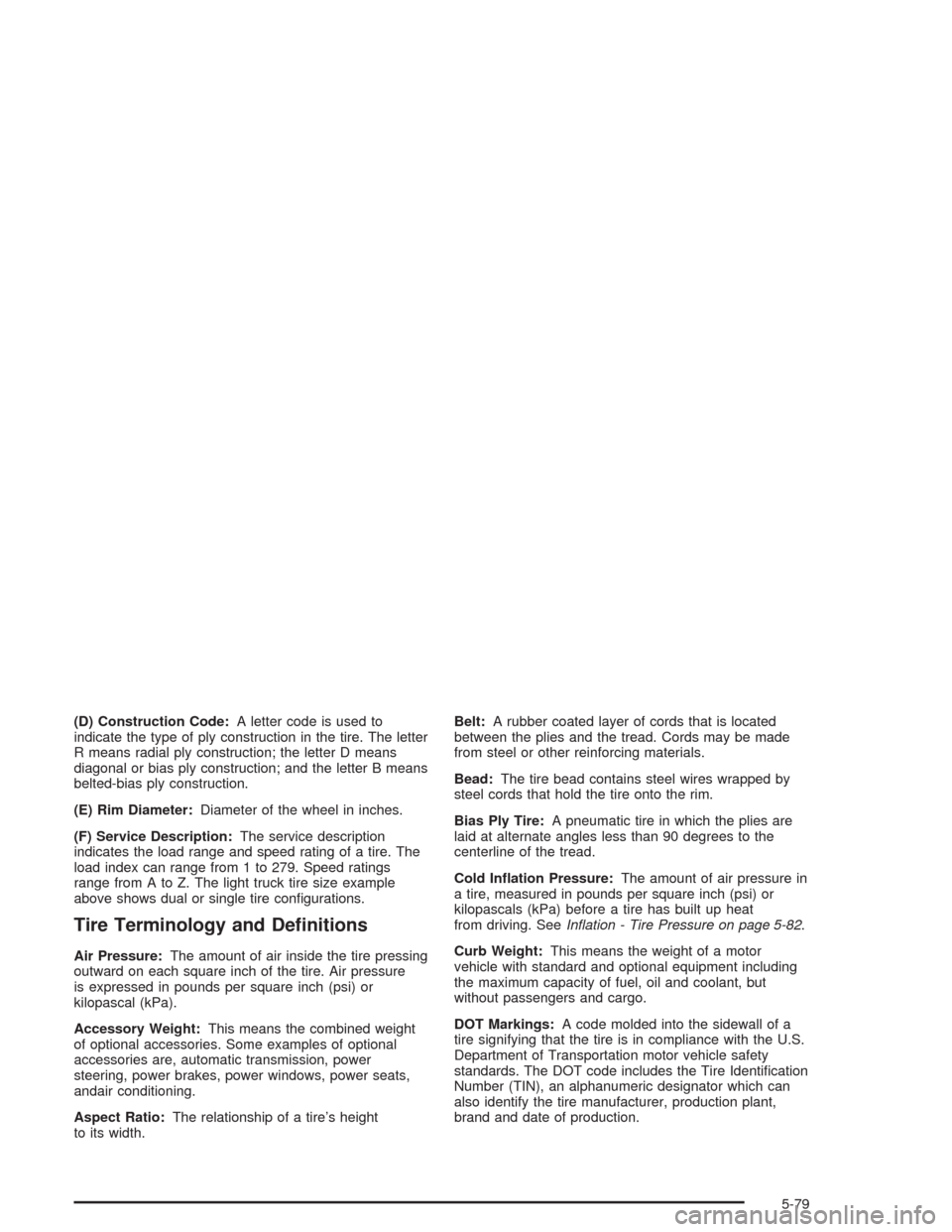
(D) Construction Code:A letter code is used to
indicate the type of ply construction in the tire. The letter
R means radial ply construction; the letter D means
diagonal or bias ply construction; and the letter B means
belted-bias ply construction.
(E) Rim Diameter:Diameter of the wheel in inches.
(F) Service Description:The service description
indicates the load range and speed rating of a tire. The
load index can range from 1 to 279. Speed ratings
range from A to Z. The light truck tire size example
above shows dual or single tire con�gurations.
Tire Terminology and De�nitions
Air Pressure:The amount of air inside the tire pressing
outward on each square inch of the tire. Air pressure
is expressed in pounds per square inch (psi) or
kilopascal (kPa).
Accessory Weight:This means the combined weight
of optional accessories. Some examples of optional
accessories are, automatic transmission, power
steering, power brakes, power windows, power seats,
andair conditioning.
Aspect Ratio:The relationship of a tire’s height
to its width.Belt:A rubber coated layer of cords that is located
between the plies and the tread. Cords may be made
from steel or other reinforcing materials.
Bead:The tire bead contains steel wires wrapped by
steel cords that hold the tire onto the rim.
Bias Ply Tire:A pneumatic tire in which the plies are
laid at alternate angles less than 90 degrees to the
centerline of the tread.
Cold In�ation Pressure:The amount of air pressure in
a tire, measured in pounds per square inch (psi) or
kilopascals (kPa) before a tire has built up heat
from driving. SeeIn�ation - Tire Pressure on page 5-82.
Curb Weight:This means the weight of a motor
vehicle with standard and optional equipment including
the maximum capacity of fuel, oil and coolant, but
without passengers and cargo.
DOT Markings:A code molded into the sidewall of a
tire signifying that the tire is in compliance with the U.S.
Department of Transportation motor vehicle safety
standards. The DOT code includes the Tire Identi�cation
Number (TIN), an alphanumeric designator which can
also identify the tire manufacturer, production plant,
brand and date of production.
5-79
Page 537 of 584
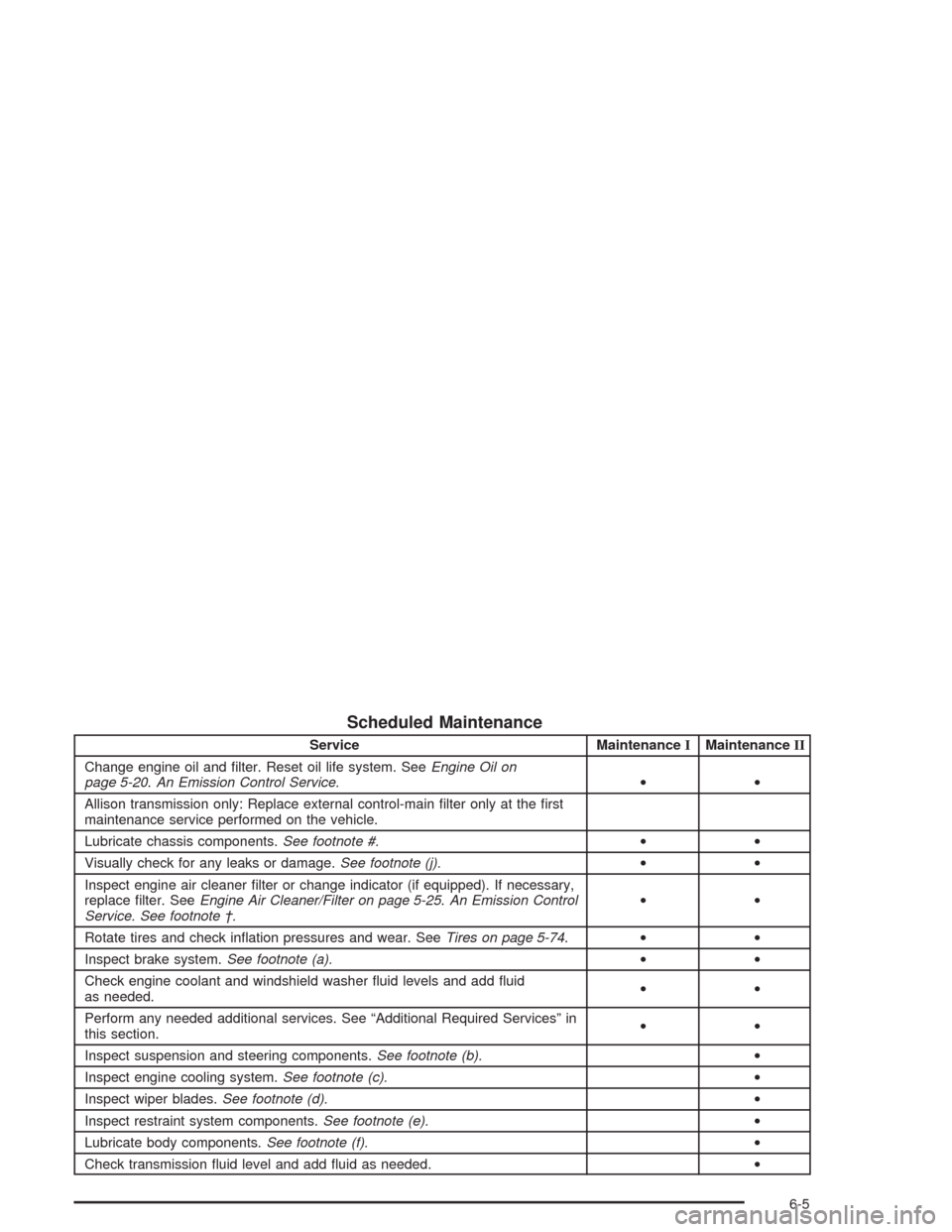
Scheduled Maintenance
Service MaintenanceIMaintenanceII
Change engine oil and �lter. Reset oil life system. SeeEngine Oil on
page 5-20.An Emission Control Service.••
Allison transmission only: Replace external control-main �lter only at the �rst
maintenance service performed on the vehicle.
Lubricate chassis components.See footnote #.••
Visually check for any leaks or damage.See footnote (j).••
Inspect engine air cleaner �lter or change indicator (if equipped). If necessary,
replace �lter. SeeEngine Air Cleaner/Filter on page 5-25.An Emission Control
Service. See footnote †.••
Rotate tires and check in�ation pressures and wear. SeeTires on page 5-74.••
Inspect brake system.See footnote (a).••
Check engine coolant and windshield washer �uid levels and add �uid
as needed.••
Perform any needed additional services. See “Additional Required Services” in
this section.••
Inspect suspension and steering components.See footnote (b).•
Inspect engine cooling system.See footnote (c).•
Inspect wiper blades.See footnote (d).•
Inspect restraint system components.See footnote (e).•
Lubricate body components.See footnote (f).•
Check transmission �uid level and add �uid as needed.•
6-5
Page 542 of 584
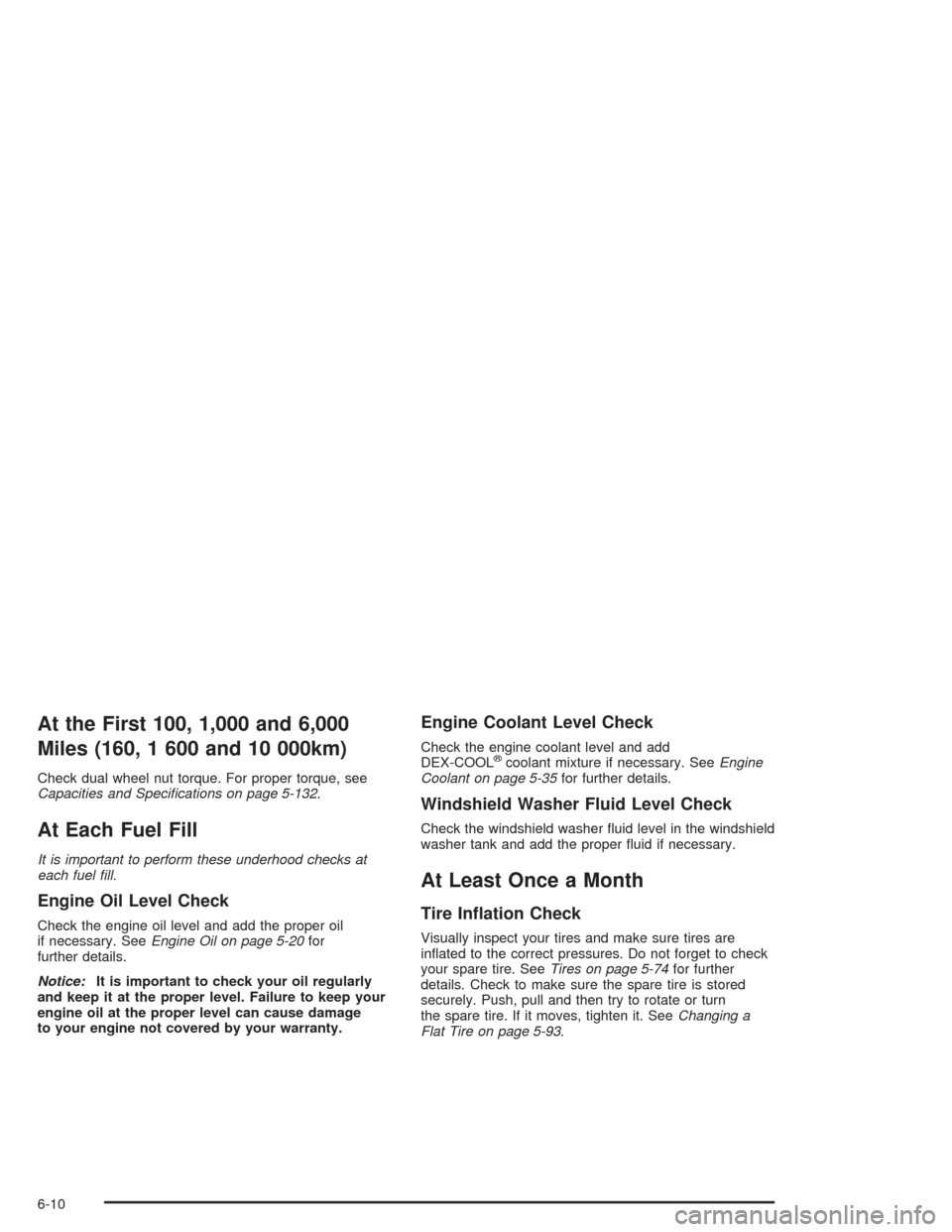
At the First 100, 1,000 and 6,000
Miles (160, 1 600 and 10 000km)
Check dual wheel nut torque. For proper torque, see
Capacities and Speci�cations on page 5-132.
At Each Fuel Fill
It is important to perform these underhood checks at
each fuel �ll.
Engine Oil Level Check
Check the engine oil level and add the proper oil
if necessary. SeeEngine Oil on page 5-20for
further details.
Notice:It is important to check your oil regularly
and keep it at the proper level. Failure to keep your
engine oil at the proper level can cause damage
to your engine not covered by your warranty.
Engine Coolant Level Check
Check the engine coolant level and add
DEX-COOL®coolant mixture if necessary. SeeEngine
Coolant on page 5-35for further details.
Windshield Washer Fluid Level Check
Check the windshield washer �uid level in the windshield
washer tank and add the proper �uid if necessary.
At Least Once a Month
Tire In�ation Check
Visually inspect your tires and make sure tires are
in�ated to the correct pressures. Do not forget to check
your spare tire. SeeTires on page 5-74for further
details. Check to make sure the spare tire is stored
securely. Push, pull and then try to rotate or turn
the spare tire. If it moves, tighten it. SeeChanging a
Flat Tire on page 5-93.
6-10
Page 573 of 584

Fluid
Automatic Transmission........................5-27, 5-30
Manual Transmission....................................5-33
Power Steering...........................................5-46
Windshield Washer......................................5-47
FM Stereo....................................................3-128
Fog Lamps....................................................3-16
Folding the Rear Seat....................................... 1-9
Following Distance..........................................4-91
Four-Wheel Drive....................................2-36, 5-60
Four-Wheel-Drive Light....................................3-51
Front Axle Locking Feature...............................2-36
Front Reading Lamps......................................3-18
Front Storage Area.........................................2-68
Fuel............................................................... 5-5
Additives...................................................... 5-7
California Fuel.............................................. 5-6
E-85 (85% Ethanol)....................................... 5-8
Filling a Portable Fuel Container....................5-11
Filling Your Tank........................................... 5-9
Fuels in Foreign Countries.............................. 5-9
Gage.........................................................3-52
Gasoline Octane........................................... 5-5
Gasoline Speci�cations.................................. 5-6
Low Warning Light.......................................3-53Fuel Information Button....................................3-56
FUEL LEVEL LOW.........................................3-66
Fuses
Fuses and Circuit Breakers.........................5-123
Windshield Wiper.......................................5-123
G
Gage
Engine Coolant Temperature.........................3-46
Fuel..........................................................3-52
Oil Pressure...............................................3-50
Speedometer..............................................3-35
Tachometer.................................................3-35
Transmission Temperature.............................3-46
Voltmeter Gage...........................................3-42
Gasoline
Octane........................................................ 5-5
Speci�cations............................................... 5-6
Getting Familiar with Off-Road Driving................4-25
Glove Box.....................................................2-67
GM Mobility Program for Persons with
Disabilities.................................................... 7-5
7
Page 577 of 584
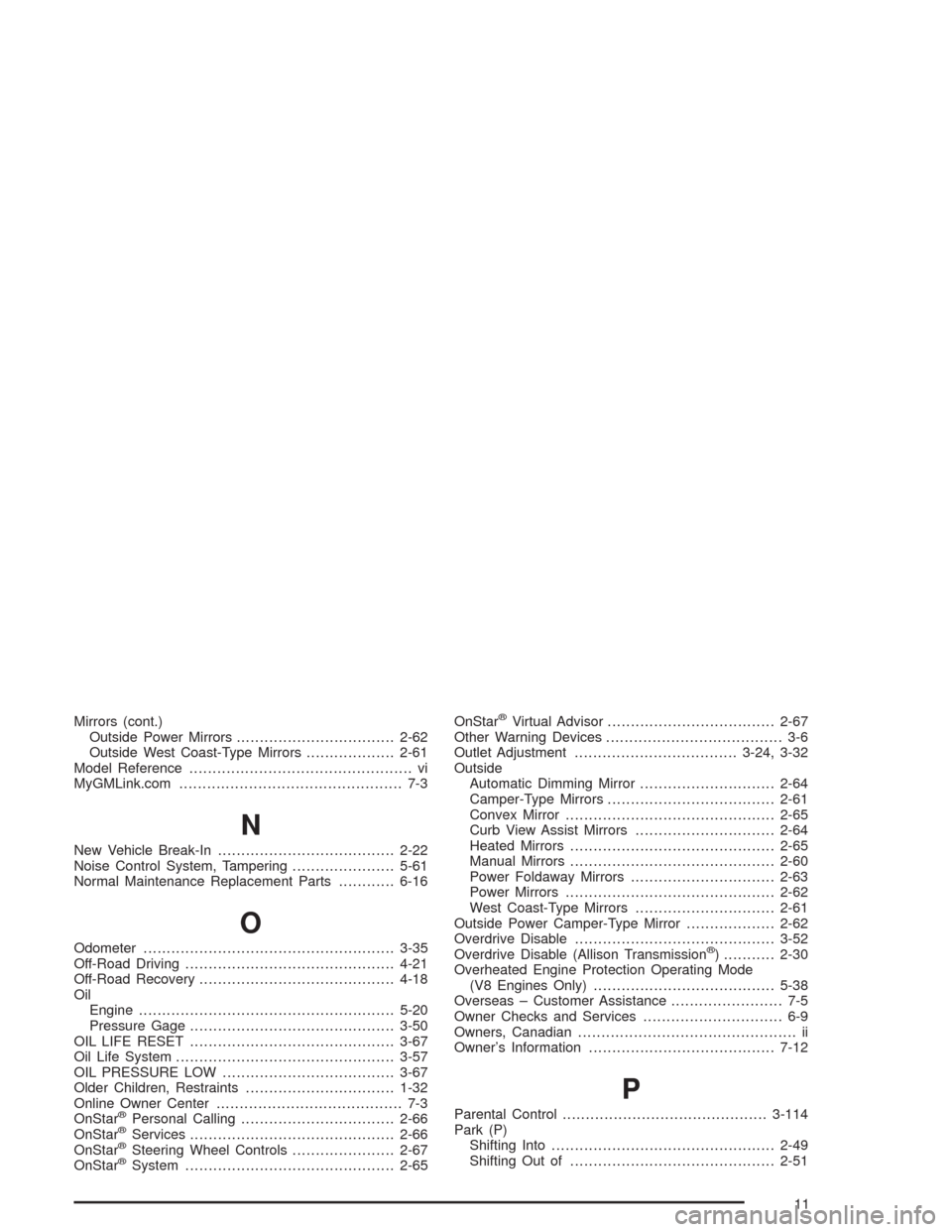
Mirrors (cont.)
Outside Power Mirrors..................................2-62
Outside West Coast-Type Mirrors...................2-61
Model Reference................................................ vi
MyGMLink.com................................................ 7-3
N
New Vehicle Break-In......................................2-22
Noise Control System, Tampering......................5-61
Normal Maintenance Replacement Parts............6-16
O
Odometer......................................................3-35
Off-Road Driving.............................................4-21
Off-Road Recovery..........................................4-18
Oil
Engine.......................................................5-20
Pressure Gage............................................3-50
OIL LIFE RESET............................................3-67
Oil Life System...............................................3-57
OIL PRESSURE LOW.....................................3-67
Older Children, Restraints................................1-32
Online Owner Center........................................ 7-3
OnStar
®Personal Calling.................................2-66
OnStar®Services............................................2-66
OnStar®Steering Wheel Controls......................2-67
OnStar®System.............................................2-65OnStar
®Virtual Advisor....................................2-67
Other Warning Devices...................................... 3-6
Outlet Adjustment...................................3-24, 3-32
Outside
Automatic Dimming Mirror.............................2-64
Camper-Type Mirrors....................................2-61
Convex Mirror.............................................2-65
Curb View Assist Mirrors..............................2-64
Heated Mirrors............................................2-65
Manual Mirrors............................................2-60
Power Foldaway Mirrors...............................2-63
Power Mirrors.............................................2-62
West Coast-Type Mirrors..............................2-61
Outside Power Camper-Type Mirror...................2-62
Overdrive Disable...........................................3-52
Overdrive Disable (Allison Transmission
®) ...........2-30
Overheated Engine Protection Operating Mode
(V8 Engines Only).......................................5-38
Overseas – Customer Assistance........................ 7-5
Owner Checks and Services.............................. 6-9
Owners, Canadian............................................... ii
Owner’s Information........................................7-12
P
Parental Control............................................3-114
Park (P)
Shifting Into................................................2-49
Shifting Out of............................................2-51
11